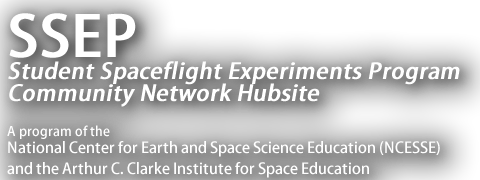The Student Spaceflight Experiments Program is proud to report that there were a total of 744 proposals submitted from student teams across the 11 communities participating in Mission 4 to ISS. Of those, 353 proposals were forwarded for review by Step 1 Review Boards in each of the communities. Each Step 1 Review Board selected three finalist proposals, which were submitted to the National SSEP Step 2 Review Board.
On May 21, 2013, the Step 2 Review Board met at the Smithsonian’s National Air and Space Museum, reviewed all 33 finalist proposals, and selected one proposal to fly for each community, for a total of 11 flight experiments. The national announcement for the selection of the Mission 4 to ISS flight experiments is provided in a June 11, 2013, SSEP National Blog post. It is noteworthy that the 744 proposals received reflected a total of 3,080 students fully engaged in experiment design.
All 33 finalist experiment teams, along with descriptions of their proposed flight experiments, are provided below. You are also invited to meet the SSEP Step 2 Review Board members for Mission 4 to ISS.
Congratulations to the over three thousand students and their teachers participating in Student Spaceflight Experiments Program Mission 4 to the International Space Station.
1. Highlands Ranch, Colorado
Jump to Highlands Ranch’s Community Profile
SELECTED FOR FLIGHT:
What Are the Effects of Creation of Beer in Microgravity and is it Possible?
Grade 6, STEM School and Academy, Douglas County School District
Principal Investigator: Michal Bodzianowski
Teacher Facilitator: Sharon Combs, Physical Science Teacher
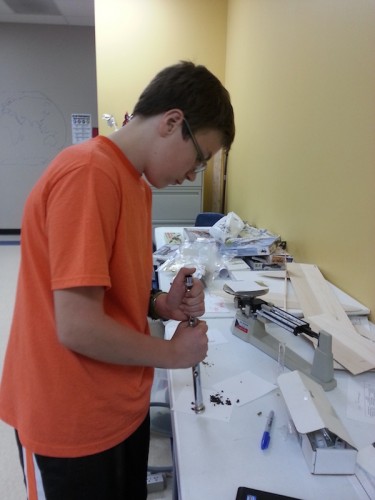
Microgravity researcher Michal Bodzianowski assessing his experiment in the Fluids Mixing Enclosure (FME) mini-lab. Click for Zoom
Proposal Summary:
By combining the four main ingredients (malt barley, hops, yeast, and water) of beer in space, will we be able to produce alcohol? This question was inspired by the use of beer as a replacement to regular water, as the alcohol killed bacteria that were in regular water. If an emergency occurred, and all water was polluted, creating beer from it will disinfect it, and it is relatively cheaper than purifying it with special tablets that may not last. And as it kills bacteria, it can also be used medically to disinfect wounds. The experiment’s results will be useful for both medical and survival reasons, and it is fairly easy to conduct with limited human interactions. Experiment will be measured by hydrometer tests to see if any alcohol was produced by the yeast-sugar reaction. References: (Hanson, 1997-2013)
HONORABLE MENTION FINALISTS:
Bacteria Reproduction in Space – Microgravity vs. Gravity
Grade 8, STEM School and Academy, Douglas County School District
Co-Principal Investigators: Pazleen Chopra, Mansi Gupta, and Kim Hulshof
Teacher Facilitator: Sharon Combs, Physical Science Teacher
Proposal Summary:
Sending bacteria up to space will provide valuable knowledge to the scientific community to understand the effect that gravity has on the growth and development of bacteria. To test this dormant Escherichia Coli will be sent up to space. Then when the test tube arrives in space the dormant bacteria will be activated by a nutrient agar. After about one and a half months in space the bacteria will be killed by bleach so that there is no extra reproduction on earth on its return flight back. While the bacteria are in space, the same experiment will be done on the ground to have a control group. When both experiments are together, the bacteria from space and the bacteria from earth will be compared. The qualities that will be looked at are the shape, the size, the strength, and the quantity of the bacteria. This can help the scientific community by understanding the effect gravity has on the growth and development of living organisms. This will also help with understanding the dangers of human reproduction in space if the earth becomes so polluted the human race must escape earth. Sending bacteria up to space to test the differences in reproduction will provide much knowledge about bacteria and the effect gravity has on the growth of living creatures.
Bone Deterioration
Grade 8, STEM School and Academy, Douglas County School District
Co-Principal Investigators: Grayson Barber, Conor O’Hara, and Adam Price
Teacher Facilitator: Sharon Combs, Physical Science Teacher
Proposal Summary:
In our experiment we will be testing how acids particularly stomach acid reacts in a microgravity environment using an analogy of a bone and vinegar. We chose to use a bone and vinegar rather than real stomach acid and food because we don’t want the acid to be so strong that the bone or the food will dissolve completely leaving us left with nothing to compare the results to. This experiment would help science and our world because if the bone deteriorates less than we know, the astronauts will need to eat slow enough so they don’t get sick due to lack of digestion. If the bone deteriorates faster than we know, the astronauts should not eat very acidic foods because this could lead to health problems (Seykans, 2011). Putting vinegar, a bone and a sponge inside of the FME will be the setup of the experiment. The vinegar will be released first and start to deteriorate the bone. Then the sponge will be released at the end of the mission to absorb the vinegar to prevent any more deterioration on the way back down to earth.
2. Indiana State Science Education Consortium (INSEC), Indiana
Jump to INSEC’s Community Profile
SELECTED FOR FLIGHT:
The Effect of Microgravity on the Development of the Salamander
Grade 6 & 8, Avicenna Academy in Crown Point, IN
Co-Principal Investigators: Ameer Rifai and Jenna Rifai
Teacher Facilitator: Mrs. Nicole Gustafson, Teacher
Proposal Summary:
This experiment will be testing the effect of microgravity on the development of the Salamander. I wanted to do this experiment because people have done a similar experiment testing frogs in microgravity and different developments have happened. I would like to see if I can find similar or new differences regarding development in gravity with an amphibious organism. Gravity plays an important role in the development process. I am curious to see if and how microgravity will effect this development. Gaining knowledge on this experiment, may lead to further exploration of other living organisms’ development, such as humans, in microgravity. For this experiment, I will be sending ten fertilized salamander eggs to the ISS where they will begin to grow and develop. Before the salamanders leave the ISS, formaldehyde will be mixed with the salamanders to stop the growth. When they return to Earth, I will observe them for any abnormalities and compare them to the salamanders on Earth.
HONORABLE MENTION FINALISTS:
Effect of Microgravity on Amoeba Reproduction
Grade 7, Avicenna Academy in Crown Point, IN
Principal Investigator: Ayesha Zubair
Teacher Facilitator: Mrs. Nicole Gustafson, Teacher
Proposal Summary:
This experiment will be testing the effect of microgravity on amoeba reproduction. I will be using freeze-dried amoebae, which will be ready to reproduce by the time I send them into space. After they come back to Earth, I will see if there are any developmental changes. A project like this has not been done before.
The Effect of Skin Cell Reproduction in Microgravity
Grade 8, Avicenna Academy in Crown Point, IN
Principal Investigator: Jenna Rifai
Teacher Facilitator: Mrs. Nicole Gustafson, Teacher
Proposal Summary:
This experiment will be testing the effect of microgravity on the reproduction of skin cells. I will be using nutrient broth as a stress relief for the cells. I wanted to do this experiment because after doing research on cells I learned that gravity has a great impact on their size, shape, structure, and development. Gravity also plays a role in how fast skin cells reproduce. I assumed that if skin cells don’t reproduce as fast in microgravity they might not reproduce as fast on an astronaut’s skin. They could also have a different structure, size, and shape. In this experiment I will freeze the cells while in transport and defrost when they go up on the ISS. They will reproduce in microgravity. When they come back on Earth I will test the skin cells in the lab and compare or contrast them with skin cells that reproduce in gravity.
3. Huron County, Michigan
Jump to Huron County’s Community Profile
SELECTED FOR FLIGHT:
The Effect of Microgravity on Calcium Absorption by Bones
Grade 7, Elkton Pigeon Bay-Port Laker Junior High School, Elkton Pigeon Bay-Port Schools
Co-Principal Investigators: Chandler Furness, Sarah Hammond, Chelsey Katshor, and Halle Keim
Collaborators: Hannah Hammond and Nicholas Wolschlager
Teacher Facilitator: Ms. Diana Schulz, 7th & 8th Grade Science Teacher
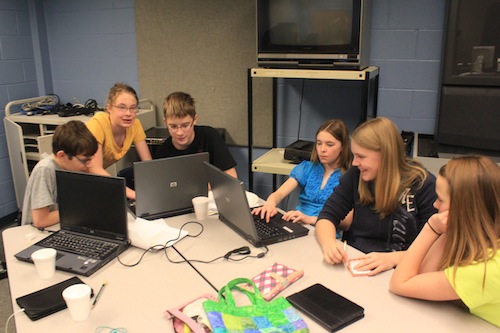
Left to right: Chandler Furness, Sarah Hammond, Nick Wolschlager, Hannah Hammond, Chelsey Katshor, and Halle Keim. The team is working on a rough draft of their proposal. Click for Zoom
Proposal Summary:
We are attempting to find out if a decalcified bone absorbs calcium in microgravity. We hypothesize that the decalcified bone will absorb the calcium from the calcium solution to sustain calcium levels in microgravity. On Earth, we predict the bone’s density will increase. We will be using a decalcified bone since harvested bone cells die without homeostasis. (Bones in Space 2009). We will x-ray, measure, and weigh the bone to determine its density/mass: 1) before it is decalcified, 2) after decalcification and, 3) after the SSEP flight. We will test our experiment on Earth by combining crushed calcium pills, buffered saline and a section of the wishbone (furcula) of a chicken (Gallus domesticus).
We used chicken bone because it fits in the nanorack tube yet the pieces from the same bone are available for testing our experiment on Earth and in microgravity. This way, we can use the other half to fulfill the requirements in space. If we used a different bone, our results may differ and would be hard to compare. We chose this topic because “when astronauts are in space they lose 14% of their bone density and scientists have yet to find a way to sustain bone density…” (Malik 2009). If we could find a way to help sustain bone density, we could help astronauts’ health. This would also allow them to continue being in space without the problem of loss of bone density, which would reduce the risk of broken bones while in space and osteoporosis.
HONORABLE MENTION FINALISTS:
Sugar Beet Germination
Grade 11-12, Laker High School, EPBP Laker Schools
Co-Principal Investigators: Brittany Smith, Alexis Moore, Katelyn Kretzschmer, and Brandon Errer
Teacher Facilitator: Deborah Hasselschwert, Science Teacher
Proposal Summary:
Sugar beets are an important crop to Huron County. The company Michigan Sugar buys sugar beets from the local farmers and processes them to make sugar. Michigan Sugar is important because it employs 940 people full-time and 1,450 people part-time, and it buys from local farmers (“Michigan”). The importance of the sugar beet plant to Huron County and that it has a small seed that grows easily making it a good plant to use in the experimental conditions (Kretzschmer). This influenced the decision to use sugar beet seeds for the experiment.
Five sugar beet seeds will be wrapped in paper towel and placed in “Volume 1” of the tube. 4 mL of water will be placed in “Volume 2” of the tube. Five days before the experiment is flown back to Earth, the clamp will be released so that the paper and seeds became wet, allowing the seeds to begin germination. Upon returning to Earth, the seeds will be planted along with a control batch that germinated on Earth. They will be measured, documented, and compared as they grow and after they are harvested. If the sugar beets grow larger, scientists and farmers can use this finding with other plants, so in times of famine, food could be grown more efficiently to compensate for the small amount of it. Because the plants would only germinate in space and be sent back to earth to grow, more plants could be produced in this way because they do not spend their entire growing period in space.
Stacking Up Density Column in Microgravity
Grade 9, North Huron Secondary School, North Huron Schools
Principal Investigator: Nicole Alexander
Co-Investigators: Emily Kosinski and Allyson Majeski
Collaborators: Katelyn Fortin, Jami Rice, and Sara Rice
Teacher Facilitator: Noreen Habana, Science and Math Teacher
Proposal Summary:
On Earth, substances stack up according to their density, with lower density materials settling above higher density materials. Keeping temperature and pressure the same, a substance’s density will remain unchanged in microgravity, since mass and volume are not altered by gravitational condition. However, a Youtube video we watched of an astronaut drinking coffee while in orbit (Pettit, 2008) intrigued us about density column in microgravity. We observed that the coffee did not settle at the bottom of the container as it does on Earth. Instead, it tended to cling against the walls of the container, 2/3 of it was vertical and 1/3 horizontal. We wondered how solutions in a density column would behave. Would they end up mixing together or will they still stack on each other according to their density, howbeit, vertically?
Our curiosity led us to more research where we found experiments conducted in the study of fluids’ behavior in microgravity. We learned that uncontained fluids form spheres, while enclosed fluids cling to the sides of their containers. We also found that engineers working with undercooked liquids are very interested in the studies of fluids in space for the ability to work with uncontained fluids. Furthermore, we learned the value of density and density column in areas such as wastewater treatment, energy consumption, and storm water management. Clearly, the study of liquid in microgravity environment reveals other nature of density and fluids hidden by gravity. What can we gain from understanding them?
4. Warren, Michigan
Jump to Warren’s Community Profile
SELECTED FOR FLIGHT:
The Formation of Silver Crystals in Microgravity
Grade 11, Macomb Mathematics Science Technology Center, Warren Consolidated Schools
Co-Principal Investigators: Steven Prascius and Sydney Waynick
Co-Investigator: Hunter Montrose
Teacher Facilitator: Mrs. Rosemarie Cybulski, Interdisciplinary Studies Teacher
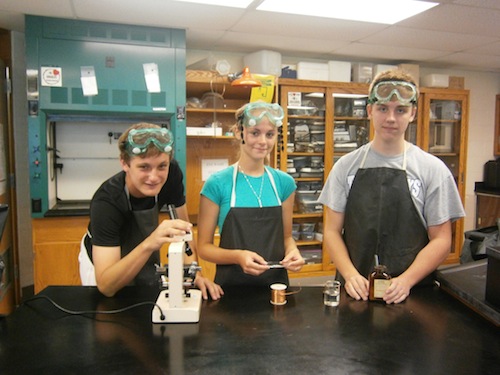
Co-PIs Steven Prascius and Sydney Waynick, and Co-I Hunter Montrose will explore crystal growth in space. Click for Zoom
Proposal Summary:
What happens to the formation of crystals in an environment with both increased radiation and microgravity? The experiment we are proposing is to test if crystals can be formed in space and if they are similar to those formed on Earth. We are testing this because crystal has been found to be able to store natural gas due to their porous and rigid nature (Porous Crystals For Natural Gas Storage). We predict these crystals to form in space as they do on earth because the actual formation of the crystals is caused by a chemical reaction that does not seem to depend on gravity for the formation of the crystals. If our hypothesis is correct and these crystals that are grown in space have the same properties as those on earth, they may show that crystals could have use in storing fuel in space. In this experiment, the crystals will be compared on their color, average size, symmetry, approximately how many faces they have, and any other structural difference between samples. Also, the masses of each sample will be measured to compare any differences in the sizes of the samples. By comparing the two samples of crystals in these categories, it will be evident if the space crystals are physically the same as those formed on earth.
HONORABLE MENTION FINALISTS:
The Effects of Micro-Gravity on the Root Structure of Rhizobium Coated Clover Seeds
Grade 10, Macomb Mathematics Science Technology Center, Warren Consolidated Schools
Co-Principal Investigators: Kathleen Hawkey, Caroline Jankowski, and Emily Liu
Teacher Facilitator: Mark Supal, Teacher
Proposal Summary:
The purpose of this experiment is to determine how a micro-gravity environment will affect the root structures of legume plants. More specifically, the experimenters will be testing how a micro-gravity environment affects the root development of clover seeds, which have been coated with the nitrogen fixing bacteria, Rhizobium. It is well known that Rhizobium forms a symbiotic relationship with clover and aids in the development of the root structure. The seeds will be sprouted and initially grown in micro-gravity. Upon return to earth, the seedlings and roots will be studied with regard to size, shape and numbers of root nodules. This experiment will be conducted by using a Type 3 FME tube that will consist of three compartments. The first volume will contain twenty clover seeds, the second volume will contain Rhizobium leguminosarum and the third volume will contain 4 ml of distilled water. Simultaneously, we will be conducting the same controlled experiment on earth. After the sprouted clover seeds return from the micro-gravity environment, we will compare their roots structures to that of the control group of seeds that sprouted on earth to determine how great an effect, if any, the micro-gravity environment had on the developing seedlings. Later, both sets of clover seedlings, experimental and control group will be planted in soil and fully grown. The sizes and shape of the plants will be compared. The experimenters have successfully sprouted clover seeds with Rhizobium within the FME and have successfully transplanted the seedlings.
The Effect of Microgravity upon the Physiology and Neurology of Spiders
Grade 10, Macomb Mathematics Science Technology Center, Warren Consolidated Schools
Co-Principal Investigators: Matthew DeSantis, Austin Morales, and Zachary Youkhana
Teacher Facilitator: Mark Supal, Teacher
Proposal Summary:
Our proposal for the Student Spaceflight Experiment Program has two components. One component is to compare the growth of spiders while in space through measurement taken on molted exoskeletons to that of corresponding spiders that remained on earth. The other component of the study is to compare the web patterns of spiders that developed in space to those that remained on earth. Upon the return to earth, the experimental group of spiders will be compared to a control group of spiders that remained on earth over the course of six weeks. In addition, the experimenters will pay attention to how well the spiders which experienced six weeks of micro-gravity environment re-adapt to an environment on earth. An important physiological aspect of the experiment is the molting of the spiders. This is a significant component of the experiment as bone mass loss is a well-known effect on humans while in space. The data collected from molted spider exoskeleton in a micro-gravity environment may or may not correlate well with similar data from humans. The data collected on spider web building capabilities after being in space for a prolonged time will shed light on how the neurology of spiders, and perhaps humans, can be affected from these conditions. The experimenters have confidence that their experiment will be successful as they have replicated the living environment in the exact sealed tubing during pre-trial here on earth over the course of six weeks and have been successful in keeping the spiders alive. If the spiders do die while in space, there will still be a preserved record of growth, up to a point, through molted exoskeletons. In addition, the experimenters have been in contact with the entomology department at Michigan State University for guidance.
5. Children First Network 201, New York City, New York
Jump to the CFN201 Community Profile
SELECTED FOR FLIGHT:
Effect of Microgravity in Structure of the Fungus Flammulina populicola
Grade 10, The Bronx High School of Science, District 10
Co-Principal Investigators: Wei Li, Alvin Wong, and Patrick Yang
Teacher Facilitator: Dr. Robert Muratore, Physical Science Teacher
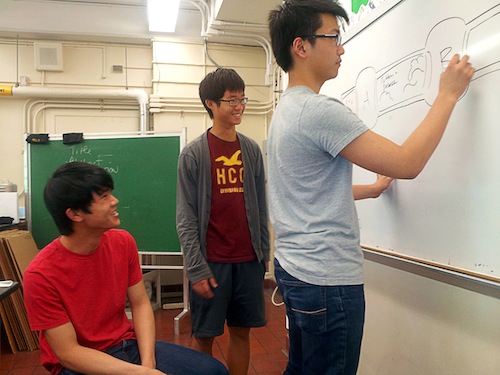
Co-PIs Alvin Wong, Patrick Yang, and Wei Li of the Bronx High School of Science plan their ISS experiment. Click for Zoom
Proposal Summary:
There are four fundamental forces that influence the entire universe, the most adverse and mysterious being gravitation. Gravity is a nearly constant force on the surface of the Earth; fractional levels can be obtained in orbital environments. As it is prevalent in our lives it is difficult to imagine the effect of microgravity on basic things although they play important roles in the development of certain objects. In this experiment we test the effect of microgravity on the fungus Flammulina populicola, classified as Basidiomycota or gill fungus (mushroom). It is previously known that gravity already has a profound effect on the growth and structural development of F. velutipes. Fungal growth from spores and growth medium (aqueous sucrose solution) in a Type 3 Fluids Mixing Enclosure in the International Space Station will be compared to fungal growth in matching enclosures on Earth. After several days the fungus will be preserved. Upon the return to Earth, the structure and growth will be compared to a control group that has been growing under the influence of Earth’s gravity. The comparison will be made by observing any evident changes and inspecting the cross-section of each sample under a light microscope.
HONORABLE MENTION FINALISTS:
The Effects of Microgravity on Phytoplankton Growth
Grade 6, New Explorations into Science, Technology and Math School (01M539), District 1
Co-Principal Investigators: Eve Newman, Matthew Rabinowitz, and Jasmine Wong
Teacher Facilitator: Marvin Cadornigara, Science Teacher
Proposal Summary:
Phytoplankton are single-celled plant-based organisms that live in water and, under the right conditions, can grow very rapidly. Our question is, “Is it possible to grow phytoplankton in a microgravity environment?” We believe that if the proper conditions are created, then the phytoplankton should be able to grow at the same rate in a microgravity environment as they do on Earth. The experiment will use a type 3 FME, with purified salt water, plant fertilizer and air in the FME main volume, the culture of phytoplanktons in the short ampoule A, and the fixative in the short ampoule B. Upon arrival on space, the short ampoule A will be broken and the FME will be shaken lightly for 30 seconds to mix its content with the main volume, aerate the fluid and expose the contents to light. This process will be repeated two more times on that day, with the FME gently shaken for another 30 seconds after 6 hours and again after another 6 hours. After 24-48 hours, the phytoplankton are expected to have consumed most of the available nutrients and the short ampoule B will be broken to release the fixative to arrest phytoplankton growth. Upon return from the ISS, the phytoplankton growth will be measured using microscopic counting, and the results will be compared to the control experiment done on the ground. Phytoplankton are the basic food source for many creatures in the ocean, and could likely be a food source for humans too. If phytoplankton can be grown in space, then they could become a healthy, and possibly renewable, food source for astronauts.
Effect of Microgravity During NASA Space Flight on Proliferation, Structural Characteristics, and ‘Immortality’ of Hela cytongartleri (HeLa) Cells
Grade 10, The Bronx High School of Science, District 10
Co-Principal Investigators: Jessica Ho and Sara Huang
Co-Investigator: Ayesha Islam
Teacher Facilitator: Dr. Robert Muratore, Physical Science Teacher
Proposal Summary:
HeLa cells were first discovered in 1951 and now have become increasingly crucial in medical research in developing treatments and medicines for viruses, cancer, and AIDs, especially because they have immortal cell lines, meaning that they can expansively divide an unlimited number of times as long as they are put in the right conditions, explaining their abnormally high proliferation rate. Due to the importance of HeLa cells in medical research, the primary objective of our experiment is to see if there will be substantial changes in the proliferation, structural characteristics, and the ‘immortality’ of HeLa cells under microgravity and increased radiation from exposure to cosmic rays during the NASA Space Flight. Previous studies show patterns of decreased cellular proliferation of other cells such as embryonic mice stem cells (An et al.) under microgravity, so we hypothesized that microgravity will cause an evident decrease in the proliferation of the HeLa cells, abnormal structure and negative effects on the cells’ ‘immortality.’ HeLa cell cultures will be prepared with DMEM, 10% FBS (fetal bovine serum) and Pen/Strep to keep the cells alive in the space and Earth NanoRacks tubes. After the flight, the experimental and control cell cultures will be examined and compared. Any evidence of differences in proliferation, structure, and ‘immortality’ of the two cell cultures will be determined. We believe that this experiment and determining the impact of microgravity on HeLa cells provides new perspective on how microgravity causes harmful health effects and how they can be treated.
6. Rochester, New York
Jump to Rochester’s Community Profile
SELECTED FOR FLIGHT:
Dehydrated and Live Tardigrades Vs. Microgravity
Grade 11, Rochester Early College International High School, Rochester City School District
Co-Principal Investigators: Cheyanne Jeffrey and Jo’ce Hill
Co-Investigator: Cierra Cannon
Collaborator: Vicki-Ann Aman
Teacher Facilitator: Ms. Mary Courtney, Science Teacher
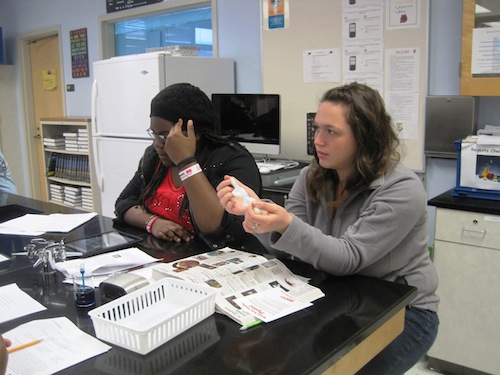
Co-PI Cheyanne Jeffrey and Collaborator Vicki-Ann Aman discuss contents of the FME during a team planning meeting. Click for Zoom
Proposal Summary:
This proposal focuses on two experiments. The first is the see whether rehydrated tardigrades in a microgravity environment have any structural and behavioral differences from the dehydrated tardigrades on Earth. The second experiment will be the same except with live tardigrades. Tardigrades are known for their ability to withstand any type of conditions. What we want to test is while dehydrated and activated in space, can they still survive or will they behave differently. The same experiment will be done on Earth. After the six weeks in microgravity, the experiment will return to Earth and we will examine them microscopically. We will then compare the two experiments and see any difference between the two. We will look for any structural and behavioral differences.
HONORABLE MENTION FINALISTS:
The Effect of Microgravity on the Growth of Brine Shrimp Eggs
Grade 10, Rochester Early College International High School, Rochester City School District
Principal Investigator: Charitie Hill
Teacher Facilitator: Ms. Mary Courtney, Science Teacher
Proposal Summary:
In my experiment, I plan to study the effect that microgravity has on the growth of brine shrimp eggs. I will compare the growth of brine shrimp eggs grown in microgravity compared to those on Earth. Both samples will include the same amount of space to grow, the same amount of water, and the same amount of nutrients/food.
Through this experiment, microgravity can help us as scientists to better understand how brine shrimp eggs are developed or the general understanding of the early development of aquatic life. This could be very significant to the development of fish eggs or aquatic life like brine shrimp, for us to have the ability for consumption for fish in space.
The Effect of Microgravity on Brine Shrimp
Grade 11, Rochester Early College International High School, Rochester City School District
Principal Investigator: Precious Harris
Teacher Facilitator: Ms. Mary Courtney, Science Teacher
Proposal Summary:
I will answer the question; how does microgravity affect the growth and development of brine shrimp? I will need saltwater, 6-8 brine shrimp eggs, brine shrimp food, an inhibitor for both samples and two FME type three tubes. If I use the Type 3 FME tubes to hold 3-4 brine shrimp eggs each, water and food and an inhibitor for each sample than I will be able to start the growth of the eggs, let them develop and then put them to sleep in space so that when they return to earth the gravity doesn’t change how they actually grew. For the control on earth I will put it to sleep also because if I don’t it will have developed longer than the other tube. In the left side of the tube there will be the eggs, in the middle will be a small amount of food and salt water and on the right of the tube will be my inhibitor. Since I am conducting a controlled experiment, I will use a microscope to evaluate the differences in development between the shrimp on earth and those that were in space. Everything that is done in space to the developing shrimp will be done to the control group on earth. The eggs will not be activated as soon as they reach space because of the limited amount of food and water.
7. Downingtown, Pennsylvania
Jump to Downingtown’s Community Profile
SELECTED FOR FLIGHT:
Aleve XR and Microencapsulation in Microgravity
Grade 9, Downingtown S.T.E.M. Academy, Downingtown Area School District
Co-Principal Investigators: Miranda Mc Millen and Christina Murray
Co-Investigators: Jenni Faust and Meghan Joyce
Collaborators: Avni Gulrajani, Connor McGrath, Cecilia Padilla, and Santina Zouras
Teacher Facilitator: Mr. Eric Daney, Physics Teacher
Proposal Summary:
The focus of this experiment is to observe how microgravity affects the release of the microencapsulated drug Aleve XR. From the outcomes of previous experiments done in space that are similar to ours, we have come to the prediction that the release rate of the drug will be prolonged. The experiment requires that the microcapsule be dissolved by a simulated stomach acid made up of hydrochloric acid, deionized water, sodium chloride, and potassium chloride. When the experiment is sent back to earth, the concentration of amphetamines released by the Aleve XR will be compared to the concentration of the amphetamines released on earth, in order to see how microgravity affects how strong the microencapsulation of the drug is. If there is a lower concentration of Aleve XR, then this means that the microcapsule is stronger in space, because the coating would have lasted longer. The results of this experiment will also provide researchers with information regarding the effects of microgravity, specifically on the release of microcapsules. Astronauts can then act accordingly on how heavy each dose needs to be in order to be effective on a particular disease. It can also contribute to manufacturing longer lasting medicines, if the microcapsule stays intact in microgravity.
HONORABLE MENTION FINALISTS:
How will microgravity affect the interaction between the chemotherapy drug, Vincristine, on white cancer cells?
Grade 9, Downingtown S.T.E.M. Academy, Downingtown Area School District
Co-Principal Investigators: Claire Foster and Alyssa Reyes
Co-Investigators: Haley Beckman, Claire Sellen, and Tasia Whaley
Collaborators: Sarah Gross, Natalie Handley, and Yoshi Sinagawa
Teacher Facilitator: Michael Sheehan, Pre-Diploma Physics Teacher
Proposal Summary:
The chosen experiment will be studied in order to understand how mutated white blood cells from a leukemia patient would be affected by Vincristine, a chemotherapy drug, under the influence of microgravity. It is hypothesized that the mixing of these two liquids will ultimately cause the leukemia cells to reproduce at a slower rate. If it is found that the leukemia decreases in strength when mixed with Vincristine in microgravity, new research opportunities will arise. This research can potentially uncover the cure to leukemia once analyzed on Earth. Puromycin will be added prior to the return to Earth, ensuring that no test results or observations are altered during the journey back to Earth. Puromycin is a growth inhibitor, and will slow the interaction between the Vincristine and leukemia cells. The addition of the Puromycin to the FME will preserve the results of the testing, so they can be analyzed when arriving back on Earth.
B Lymphocyte Infection-Fighting Abilities in Microgravity
Grade 9, Downingtown S.T.E.M. Academy, Downingtown Area School District
Co-Principal Investigators: Marcello Cesario and Alison Dougherty
Co-Investigators: Danielle Moser and Lucas Steadman
Collaborators: Jeremy Barr, Daniel Bryer, Steffani O’Neill, and Anthony Toomey
Teacher Facilitator: Michael Sheehan, Physics Teacher
Proposal Summary:
The immune system, used to combat disease and illness, is primarily dependent upon T-cells and the B lymphocytes. Without the B lymphocytes specifically, the human body would be completely receptive to illness; therefore, the knowledge of microgravity’s effect on B lymphocytes is essential for NASA’s understanding of human health in microgravity. The B lymphocytes can be tested by allowing a sickness – in this experiment, the human corona virus – to interact with healthy blood. Observations must be made concerning whether or not the B lymphocytes have been produced and whether the virus is beaten by the blood. Blood glucose levels can measure the presence of illness, and the presence of antibodies can be measured using an antibody assay kit. The predicted outcome is that, unfortunately, the production of antibodies will be inhibited by exposure to microgravity. This experiment seeks to investigate this outcome.
8. Jamestown, Pennsylvania
Jump to Jamestown’s Community Profile
SELECTED FOR FLIGHT:
Bacteria and Decomposition
Grade 9-10, Jamestown High School, Jamestown Area School District
Principal Investigator: Jason Liszka
Co-Investigators: April Minto, Cade Lamont, Sydney Holler, and Trey Saulsbery
Co-Teacher Facilitators: Chalsie Kennedy, Spanish Teacher and Harry Rohrbacher, Biology Teacher
Proposal Summary:
Our project will take a closer look at a bacteria’s ability to decompose soil in space. In order to have human beings live safely in outer space for extended periods of time, it is important to look at one of Earth’s decomposer’s ability to function in microgravity. If life is going to be sustained in space, it is important to see if a decomposer is capable of breaking down waste and adding nutrients to the soil.
HONORABLE MENTION FINALISTS:
Effects of Microgravity on Solidification
Grade 7-8, Jamestown High School, Jamestown Area School District
Co-Principal Investigators: Jonathan Shultz, Caden Randell, and Jarron Mihoci
Co-Investigator: Danielle Reinhart
Collaborator: Gabriella Foulk
Co-Teacher Facilitators: Susan Snyder, Life Science Teacher and Harry Rohrbacher, Biology Teacher
Proposal Summary:
We believe that concrete had different effects in microgravity and may lead to improvement for future space exploration. Concrete produced at zero gravity could possibly be stronger than that produced on the earth. By mixing concrete in space, we can learn more about the strength of the mixed concrete in microgravity. The ratio of distilled water to quick-crete is 2:8. In our procedure we used that ratio of water and quick-crete to make concrete. We believe that the effects in microgravity will produce a cement product different from that created on Earth. Stronger cement can help develop stronger structures both in space and on Earth.
The Effects of Microgravity on the Hatching of Rainbow Trout Eggs
Grade 11-12, Jamestown High School, Jamestown Area School District
Co-Principal Investigators: Alexis Goodlin and Scott Miller
Investigator: Alissa Owen
Collaborator: Shannon Potter and Clayton Shirey
Teacher Facilitator: Harry Rohrbacher, Biology Teacher
Proposal Summary:
Under conditions of microgravity, produced by the free-fall characteristics of the International Space Station, the hatching period and growth of fish embryos may be affected. The purpose of this experiment is to explore the potential effects upon fish embryos, under controlled conditions (temperature, light, water chemistry). Potential effects may include birth defects, and they may also result in the death of the embryo prior to hatching. This experiment may prove useful in the future for transportation of embryos to a human-based, extra-terrestrial civilization. The project may also produce positive results, resulting in a genetically superior breed of trout. In addition to this, space egg hatching methods could be used to avoid the spread of disease that affects fish at young ages. Over the period of six weeks, the embryo should develop into the “eyed” egg stage and should hatch under a temperature around 70-75 °F. If chosen to travel, this experiment can broaden the horizons of those involved with fish development, in turn, affecting all connected in one way or another.
9. North Charleston, South Carolina
Jump to North Charleston’s Community Profile
SELECTED FOR FLIGHT:
The Effect of Microgravity on the Oxidation of Metal Exposed to a Salt Water Solution
Grade 7, Palmetto Scholars Academy, South Carolina Charter School District
Co-Principal Investigators: Griffin Eslinger and Alexander Puckhaber
Teacher Facilitator: Mrs. Kellye Voigt, Science Teacher
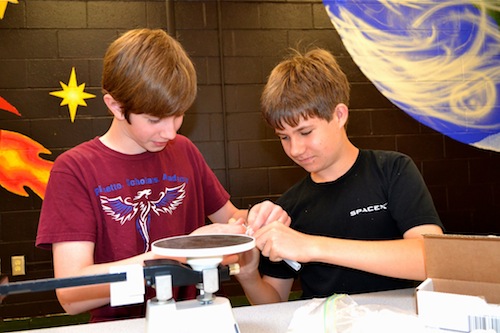
Future Drs. Griffin Eslinger and Alex Puckhaber assessing pH of saltwater solution before introduction into the FME mini-lab. Click for Zoom
Proposal Summary:
We want to examine the structural integrity of iron exposed to a saltwater solution in microgravity. We think that the oxidation will change because the surface tension of the liquid in space is more apparent than in normal gravity. We chose iron for our experiment because it rusts quickly and will be easier to examine during a limited time frame of the experiment.
We will use a type 2 fluid mixture enclosure (FME) with salt water on one side and an iron bar and oxygen in the other. The iron bar will be the kind used for metal tensile testing; the oxygen and salt water will oxidize it. The two will mix when the astronaut releases the clamp and shakes the container. We will have three test samples, one with salt water in space, one with salt water on Earth, and one with no salt water on Earth. Once we get the product of the three experiments, the two on Earth and the one in microgravity, we will test them. We will use a metal tensile test to measure the integrity of the iron bars, and a scanning electron microscope to look for differences in corrosion.
Knowing how liquids in microgravity affect the oxidation of metals is important when designing containers for the International Space Station and manned spacecrafts. This will also be useful in understanding oxidation in low gravity environments like on the moon or Mars.
HONORABLE MENTION FINALISTS:
How does microgravity affect the formation of tin whiskers on lead-free solder?
Grade 8, Palmetto Scholars Academy, South Carolina Charter School District
Co-Principal Investigators: Joseph Garvey and Gabriel Voigt
Teacher Facilitator: Mrs. Kellye Voigt, Science Teacher
Proposal Summary:
Tin whiskers are a modern problem that can destroy any device with lead-free solder. Tin whiskers are thin crystalline structures that come from metal that is covered with tin, tin solder, or metal that is plated with tin. These tin whiskers can cause a short circuit of a device by creating a new current. They have destroyed planes and satellites, costing millions of lost dollars. Today there is a modern belief that zero gravity and microgravity cause tin whiskers to be created faster. Though a lot of people think this, several people at NASA believe that microgravity and zero gravity do not make a difference in how fast tin whiskers are created. We believe that tin whiskers develop because of compression and stress instead of microgravity.
Our team would like to send up a tin whisker test bed to represent solder and compare it to one that was left here on Earth. The test bed would be made of a brass substrate electrically plated with tin. In addition, a printed circuit board would be sent, too, and would be compared with an identical circuit board on Earth. The test bed would increase the chances of tin whiskers occurring, and the printed circuit board would be an authentic representation of circuitry present on satellites and other in-orbit machinery. With this data, we should be able to determine if microgravity affects the development of tin whiskers.
Red Blood Cells in Space
Grade 9-10, Palmetto Scholars Academy, South Carolina Charter School District
Co-Principal Investigators: Delaney Chariker and James Black
Co-Investigators: Christopher Otap and Madeline Bessinger
Teacher Facilitator: Mrs. Kellye Voigt, Science Teacher
Proposal Summary:
The purpose of this experiment is to test the effects of microgravity and increased radiation on stored red blood cells (RBCs). This would be tested by sending red blood cells to space as well as having a control group on Earth. After the experiment, the extracellular material would be analyzed. Analyzed would be the mass and volume of the red blood cells as well as how well the cells survived. Using technetium-99m, chromium-51, and indium-111 as indicators for survival. This is an important topic to research because it pertains to the health of astronauts.
10. Hays County, Texas
Jump to Hays County’s Community Profile
SELECTED FOR FLIGHT:
L. acidophilus Bacteria Growth in Microgravity
Grade 5, Ralph Pfluger Elementary School, Hays CISD
Principal Investigator: Emily Vladyka
Co-Investigators: Avery Bentz, Caden Stewart, and Emma Hodges
Teacher Facilitator: Lavada Ferguson, 5th Grade Teacher
Proposal Summary:
We are testing L. acidophilus bacteria growth in microgravity. A L. acidophilus bacterium is a probiotic bacterium that is important for bone strength and intestinal health in humans. People get probiotic bacteria from yogurt and other dairy products. The body produces these bacteria in the intestinal tract, but the amount produced is not enough to keep you healthy.
If humans eventually colonize space or another planet, we will need ways to stay healthy. A Probiotic bacterium is one way to keep the body strong and healthy. Because of the importance of these bacteria to the human body, we wonder if microgravity has any effect on its growth.
HONORABLE MENTION FINALISTS:
Life Cycle Growth of Tenebrio molitor in Microgravity
Grade 5, Carpenter Hill Elementary School, Hays CISD
Co-Principal Investigators: Sarah Barlow and Sydney Collins
Co-Investigator: Ariel Nevarez
Collaborators: Genevieve Nhan and Chloe Swanson
Teacher Facilitator: Lori Shultz, SSEP Community Program Director – Hays CISD
Proposal Summary:
Our experiment is testing the effect of microgravity on the morphing from larvae to pupae for the Tenebrio molitor, the mealworm. We wanted to know if the lack of gravity made a difference in the speed of the transitions between the stages. The Tenebrio molitor, belonging to the Tenebrioade family, progresses on to their next stage of their life cycle, either quickly or slowly depending on the temperature. We wondered whether gravity would have an effect on the speed of this transition. We would raise the Tenebrio molitor in the same exact environment as on Earth for our “ground truth experiment” and observe their reaction to the experiment in microgravity.
Aerogel in Space
Grade 5, Ralph Pfluger Elementary School, Hays CISD
Principal Investigator: Marley Rivera
Co-Investigators: Cassily Crumley and Kendra O’Donnell
Collaborator: Hayli Hutcheson
Teacher Facilitator: Lavada Ferguson, 5th Grade Teacher
Proposal Summary:
Aerogel is a super absorbent material used in many everyday things such as makeup, cigarette filters, and refrigerator insulators. It has been used by NASA as an insulator to keep the Mars Rover warm. It was also used to collect stardust from fast moving comets. NASA has found many ways to use this cool material.
We have found a use for this material on the ISS and other mechanical objects in space. We think that this material can help with toxic spills. Aerogel will be more helpful than a simple wash rag. This material will help the astronauts clean certain things up. It can catch floating liquids and stop small spills from turning into larger ones.
Although this has been used by NASA to catch stardust and as an insulator, we have found another way to use it. Aerogel can be used as a sort of sponge to absorb harmful chemicals. We think that this is definitely a handy item to have around, just in case.
11. Pharr, Texas
Jump to Pharr’s Community Profile
SELECTED FOR FLIGHT:
How does microgravity effect the growth of mold on bread?
Grade 5, Cesar Chavez Elementary, PSJA ISD
Co-Principal Investigators: Brianna Azuara and Amanda Chavez
Teacher Facilitator: Celena Miller, Science Teacher
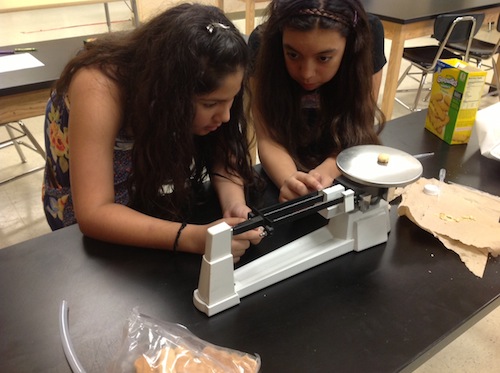
Future scientists Brianna Azuara and Amanda Chavez measure the mass of their samples during the experiment design phase. Click for Zoom
Proposal Summary:
How does microgravity affect the mold growth on bread? We are hoping to learn from our question. We want to know how mold on bread reacts differently on Earth than in microgravity, and will use “Gerber Graduates for Toddlers Lil’ Biscuits”.
The procedures for conducting our experiment in microgravity are as follow. First, the biscuit will arrive packaged and refrigerated to Houston. Then, put the biscuit (2 grams) inside the Nanoracks minilab, which will be separated by a clamp. Finally, on A+2 the astronauts will slowly open the clamp letting two milliliters Aquafina distilled water drop, giving the biscuit moisture to start growing mold.
Once returned to Earth we will take observations by observing the biscuit’s color, texture, thickness of mold, and also by viewing the slide of the mold spores under the microscope. We are also going to do an exact replica of the experiment on Earth at the same time as the experiment conducted in microgravity, so we could compare both experiments.
After this project, I will want to learn and discover how mold will react on other planets. It will be interesting to compare mold growth on different parts on space, on microgravity and in our planet Earth. By getting our answer to our question it will improve people’s current understanding of mold and how it reacts both on Earth and in microgravity. This experiment can solve all unknown questions that lots of people have waited to be answered. This is the future of all science questions!
HONORABLE MENTION FINALISTS:
What are the effects of microgravity on Sea Monkeys?
Grade 5, Cesar Chavez Elementary, PSJA ISD
Co-Principal Investigators: Anthony Barrerio and Ryan Lopez
Teacher Facilitator: Celena Miller, Science Teacher
Proposal Summary:
Our team would like to know how microgravity affects growth of brine shrimp. We would also like to know how the brine shrimp reproductive system is affected by microgravity. Our experiment proposal is to send the brine shrimp at dormant state in a Type 3 FME to later hatch and measure the growth of the brine shrimp and determine if growth is delayed or altered because of microgravity; in essence, we would like to know how reproductive system is affected. The experiment addresses the question posed by allowing the brine shrimp to grow, then measuring reproduction will be monitored and recorded.
Does microgravity affect bean plants?
Grade 5, Cesar Chavez Elementary, PSJA ISD
Co-Principal Investigators: Daana Bazaldua, Yaneth Garza, and Karen Velazquez
Teacher Facilitator: Celena Miller, Science Teacher
Proposal Summary:
We want to learn if microgravity affects the life cycle of a bean plant. We are also hoping to learn if microgravity affects the soil of the bean plant. This experiment will probably help future astronauts if the bean plant responds differently on space than on Earth. Also people will know that sometimes microgravity will affect the metamorphosis or the incomplete life cycle.
